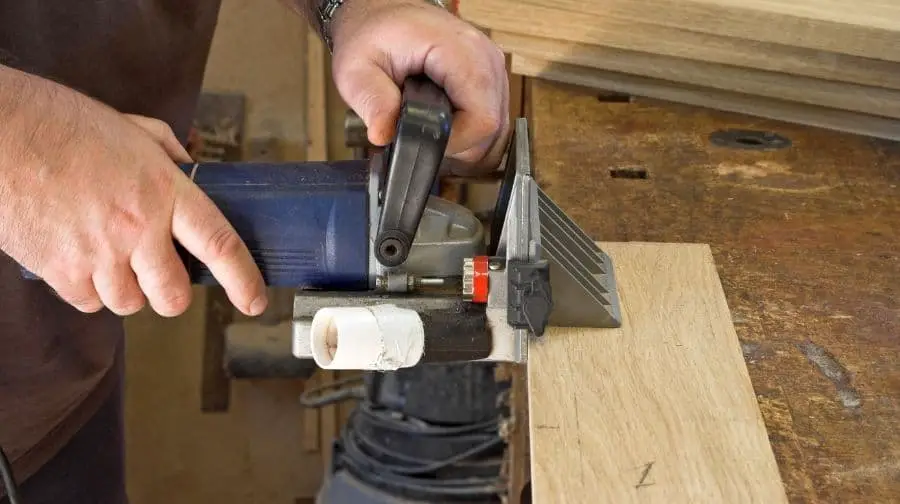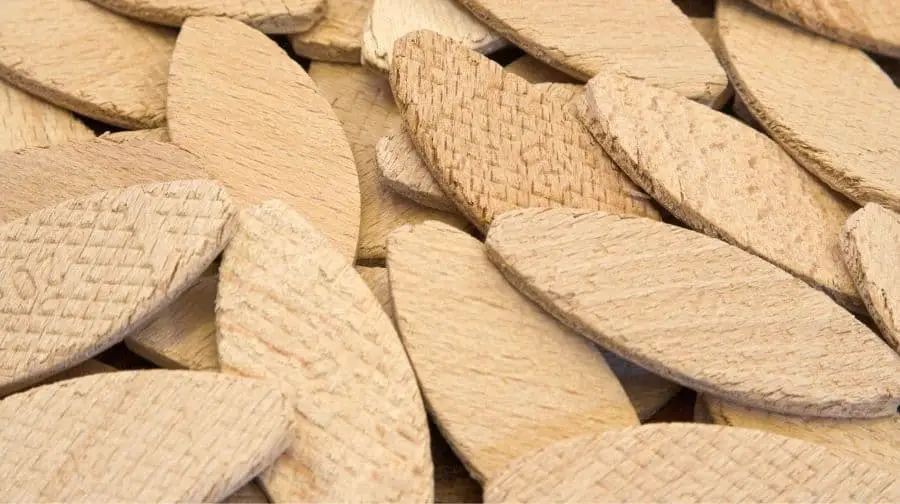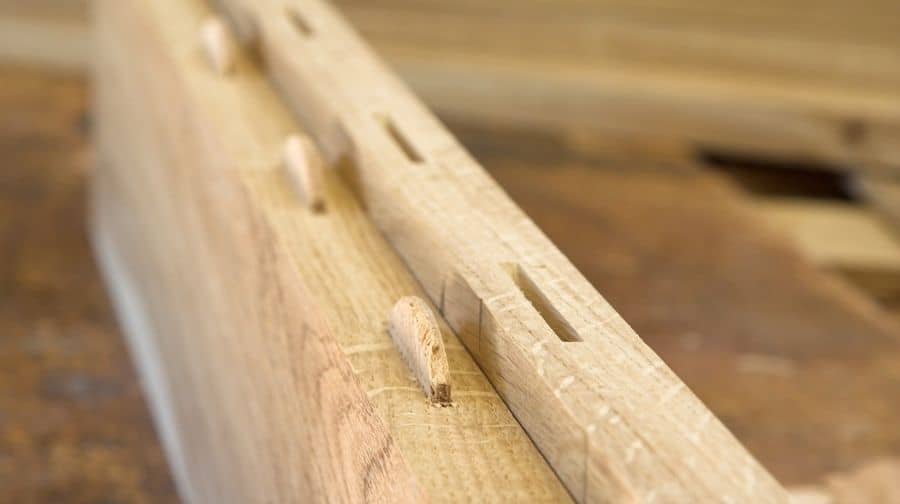
A biscuit joint can be helpful to align long edge to edge joints, as well as strengthen weaker joints that use glue such as butt and miter joints.
What is a biscuit joint used for? Biscuit joints can also be used as a replacement for mortise and tenon joints as they are easier to create, invisible, saves time and the strength is almost as good. They are used for making joining any two pieces of wood, boxes, edge to edge joints, face to edge joints, end to edge joints, rail to leg offset joints, cabinets, paneling, drawers, face frames, miters, edge banding and cabinet carcasses. The biscuits are over shaped and made out of beech wood. They come in 3 standard sizes 20, 10 and 0. The size 20 is perfect for joining 3 quarter inch and larger material, the 0 size is good for face frames, drawers and other thin or narrow stock.
Keep reading below to get a more in-depth look on biscuit joints and what they are used for.
Table of Contents
What Is A Biscuit Joint Used For?
A biscuit joint is also known as a plate joint. It is a somewhat older method of joining wood together and in the 1900s plenty of woodworkers had a biscuit joiner tool handy. They became popular rather fast because they allowed woodworkers to create strong, invisible joints quickly.
They can mostly be found in work involving sheet materials such as plywood, particleboard, and fibreboard. Biscuit joints can also be used as a replacement for mortise and tenon joints as they are easier to create and the strength is almost as good.
They are used for making joining any two pieces of wood, boxes, edge to edge joints, face to edge joints, end to edge joints, rail to leg offset joints, cabinets, paneling, drawers, face frames, miters, edge banding and cabinet carcasses. The biscuits are over shaped and made out of beech wood. They come in 3 standard sizes 20, 10 and 0. The size 20 is perfect for joining 3 quarter inch and larger material, the 0 size is good for face frames, drawers and other thin or narrow stock.
Curious about What Is A Miter Joint Used For? Please consider reading our article about the topic at this link here https://topwoodworkingadvice.com/what-is-a-mitre-joint-used-for/
How to Make a Biscuit Joint
Subscribe to Family Handyman on Youtube
Are Biscuit Joints Strong?
Biscuit joints are not known for being amazingly strong in the realm of woodworking joints. In their modern use, woodworkers typically use them more for alignment purposes rather than for strengthening.
Biscuit joints can add a small amount of extra strength to certain types of joints, especially ones that rely on glue to bond the wood together. This makes the biscuit helpful because it provides an extra layer of strength to that joint.
Are Biscuit Joints Necessary?
There are a small number of uses for biscuit jointers, but they might not be enough to justify purchasing a biscuit jointer. To start off, biscuit joints can be helpful to align pieces of wood together when creating a flat surface.
Biscuit joints can also be used to strengthen a miter joint, which is otherwise pretty weak on its own. Just keep in mind that the space that needs to be cut for the biscuit joint needs to be smaller than the miter joint’s corner for it to be effective. Also keep in mind that the biscuit joiner cuts pretty wide slots, so it would be hard to do this with a narrow piece of wood.
In general, you should be able to use a biscuit joiner on an edge-to-edge joint, a T joint, an edge miter joint, a corner joint, an offset joint, and a frame joint.
Curious about What Is A Dado Joint Used For? Please consider reading our article about the topic at this link here https://topwoodworkingadvice.com/what-is-a-dado-joint-used-for/

How Does A Biscuit Joiner Work?
Making a biscuit joint requires using a biscuit joiner tool. It is really easy to use compared to other jointing methods. Simply clamp your piece of wood in place, align the tool on the end that you want to join, and use the tool towards the piece of wood.
Once you have cut the slot, it is time to insert the biscuit into it. Your biscuit should fit pretty tightly into the slot so that the joint is effective. If you are unable to muscle it in, you can give it a couple of taps with the hammer. The same goes for your second piece of wood that you attach afterward.
How To Make A T-Joint With A Biscuit Joiner?
A T-Joint is a common method of attaching a fixed shelf to something like a bookshelf. You want to start by marking the sides to indicate the top level of the self. Lay the shelf into position and mark where you will be placing the biscuits with a pencil.
Once you have marked it with a pencil, clamp the shelf to the side, lined up with the pencil marks. Make sure that the edges are flush. Now you can cut the biscuit slots on both the side and the shelf, lined up with your original markings.
How To Make An L-Joint With A Biscuit Joiner?
The technique used to make an L-joint is very similar to that of a T-joint. The main difference is that for the L-joint you will want to use the fence on the biscuit joiner. To start, you must clamp your workpiece in place so that it hangs over the edge slightly.
Using the fence will help support the biscuit joiner since the workpiece will be hanging off the table and you need the joiner to stay in place to get a good biscuit slot.
To cut the vertical piece, use a clamp to hold the work piece in place. If you clamp it with an extra scrap piece of wood, the biscuit joiner fence will have more support to rest on. You can now cut the biscuit slots when both pieces of wood are clamped in firmly.
Curious about What Is A Knapp joint? Please consider reading our article about the topic at this link here https://topwoodworkingadvice.com/what-is-a-knapp-joint/

How To Glue A Biscuit Joint?
After you have cut the biscuit slots in your pieces of wood, put the biscuits into each slot without the glue on them. Clamp the pieces of wood together so that you can ensure all of your slots were cut correctly and that everything aligns properly.
Once you see that everything is positioned well, you are ready to glue the biscuit joints into place. Make sure that you use a water-based glue, such as regular yellow woodworking glue. The water in the glue will swell the biscuit, making for a stronger joint.
Put the glue into each slot, and don’t put it onto the biscuits themselves. You can spread the glue around with a popsicle stick to make sure that it sticks onto all areas of the biscuits. Again, this will help create a stronger joint because all of the biscuits will be stuck to the wood.
Put the adjoining pieces of wood back on without glue and their slots, and take the time to tighten your clamps and align the piece to your liking. The glue will still be swelling the biscuits at this point, so you still have time to take the pieces off and glue the other slots. Once everything is tight and aligned well, repeat the gluing process for the other side.
What Are The Advantages Of A Biscuit Joint?
The major advantage of biscuit joints is that they provide you with a quick and easy way to align parts that are glued together. This works well for joining pieces of wood together to create a long flat surface.
Another advantage is that biscuit joints can provide a small amount of extra strength for joints that would otherwise be weak on their own, such as butt and miter joints. For this reason, if you are someone who makes frames a lot, or uses these joints for other projects, it could be worth having a biscuit joiner so that you can speed up your work and add some strength.


